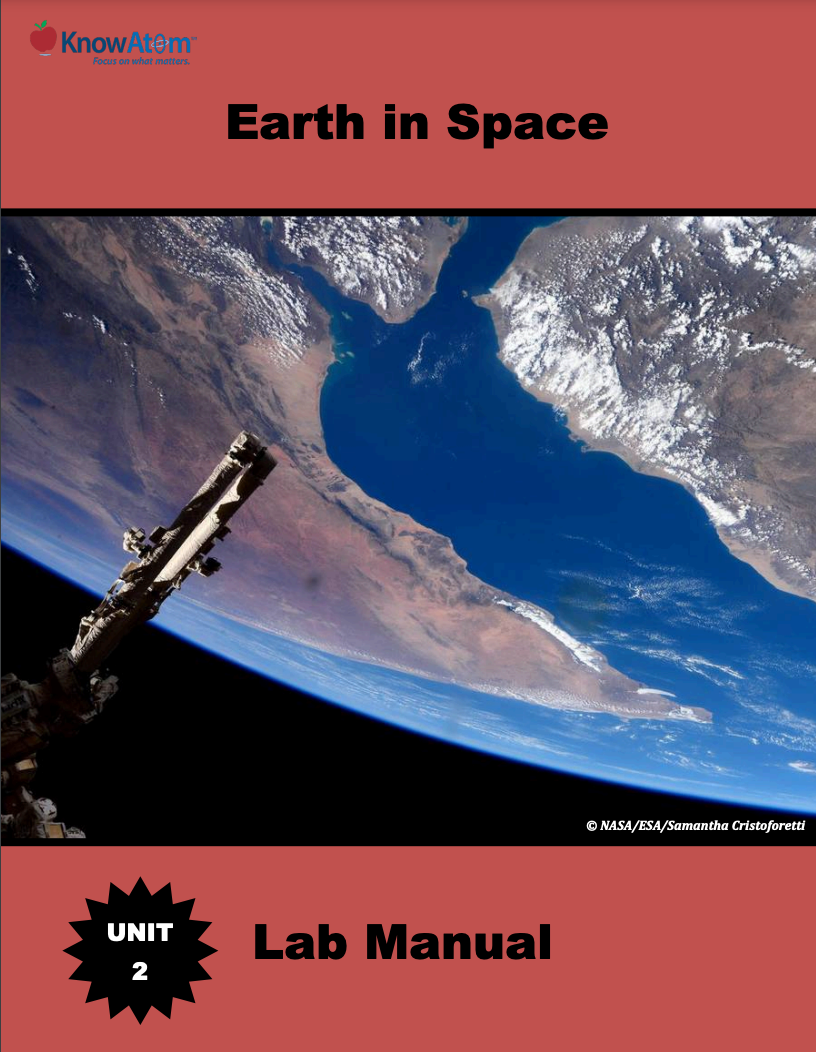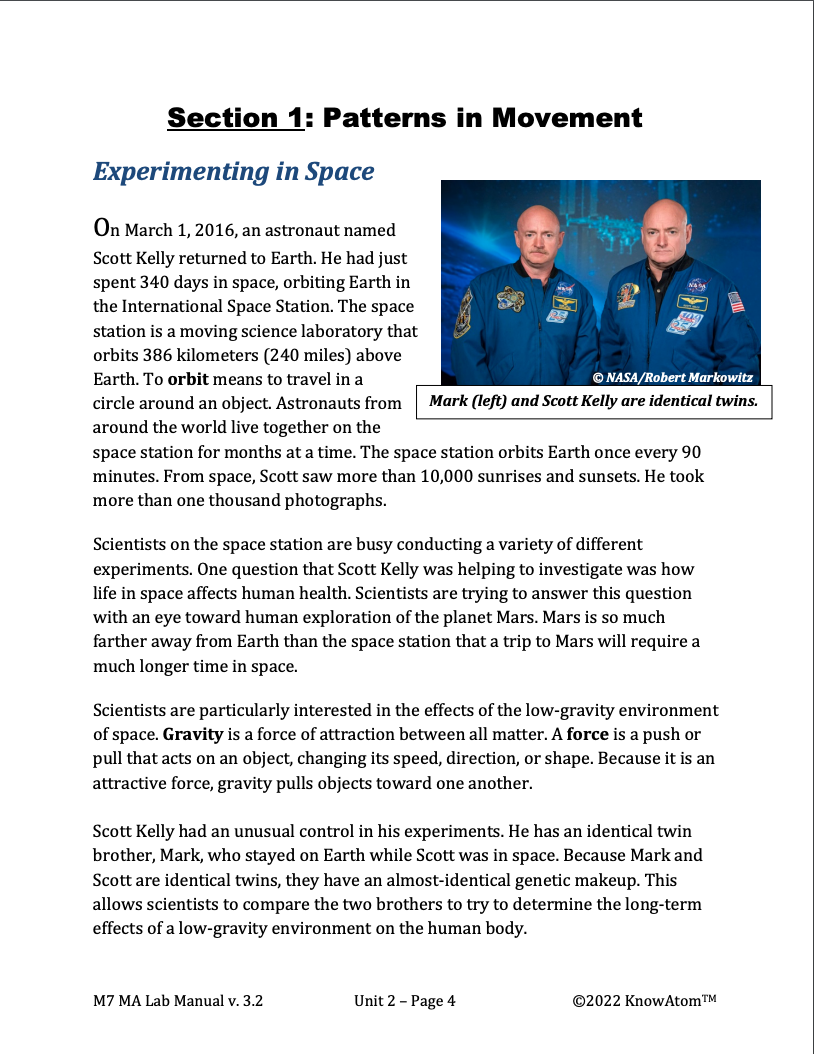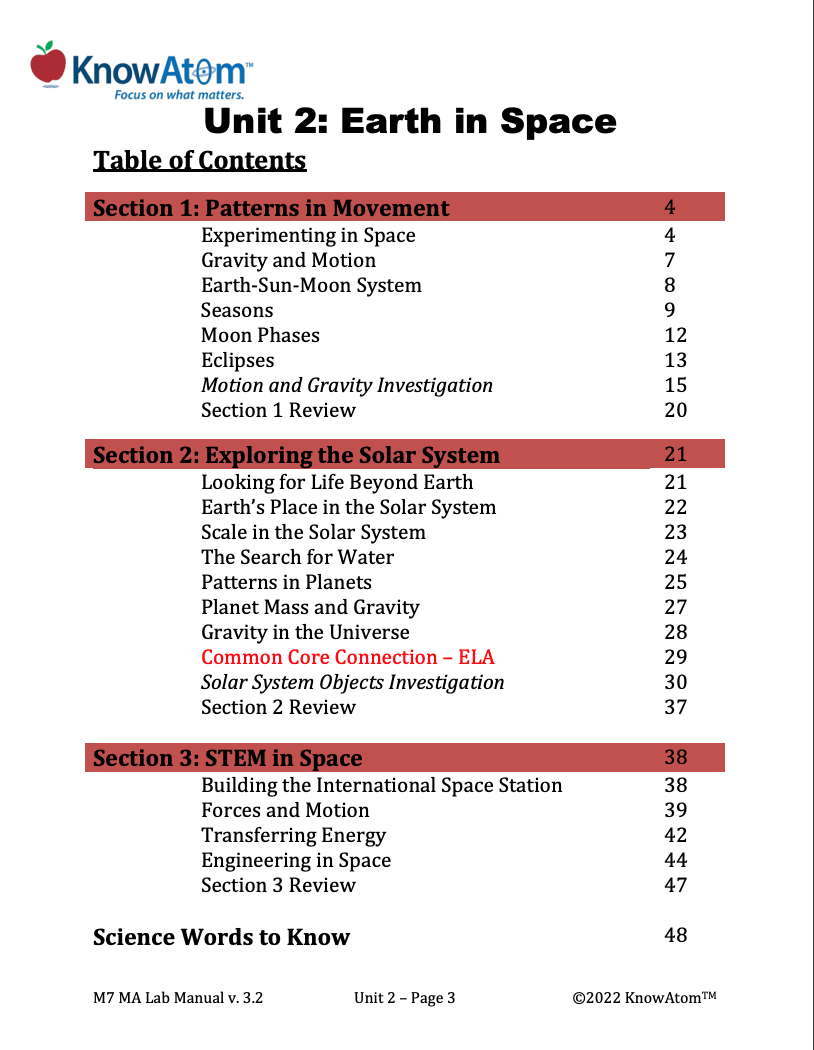In this lesson, students analyze how objects can transfer energy in a collision, tracing how energy changes from one form to another in an energy system and then exploring the relationship between an object’s mass and its speed.
In this unit, students explore the vastness and mysteriousness of the universe. For this lesson, students evaluate gravity’s role in forming the solar system and how mass and gravity determine weight on other planets. Students also investigate how a collision changes the motion of objects of different masses, connecting the change in motion with the amount of energy transferred between objects. This page provides a high-level overview of this lesson.
Science background provides teachers with more in-depth information about the phenomena students explore. Below is an excerpt of the science background on the Earth-sun-moon system.
When humans travel to space, they need to use rockets that are designed by engineers. For example, scientists and engineers had to send separate parts of the space station on rockets because there is no rocket powerful enough to launch the entire station into space at one time. It took more than 40 missions to get all of the materials into space and assembled. The completed space station has a mass of almost 453,592 kilograms (1 million pounds).
Engineers who design rockets to launch into space apply three basic laws of motion that describe how forces cause objects to move. These three laws were first described by a scientist called Sir Isaac Newton in the 1600s. Newton was fascinated by how things move. After much study, he realized that the motion of all objects follow the same three basic laws.
Newton’s first law of motion describes inertia. Remember that inertia has a role in a moon or planet’s orbital motion. Newton observed that when all of the forces acting on an object are balanced, the object will not change its motion. When the forces acting on an object are equal, they are balanced. Stationary objects won’t start moving, and moving objects won’t stop moving unless the forces pushing or pulling on these objects become unbalanced. Unbalanced forces occur when two opposing forces acting on an object are not equal.
In order for the space rocket to be launched, it needs an unbalanced force to cause it to move. Unbalanced forces cause movement because they transfer energy into or out of objects or systems. Remember that energy is the ability to do work.
When an unbalanced force is applied to an object, energy transfers to that object. This transfer of energy changes the motion of the object.
The reason the space station couldn’t be launched once it was built was because of the relationship between the mass of an object and the amount of force needed to move it. This takes us to Newton’s second law, which says that the amount of force needed to move an object any distance depends on its mass. It is written as an equation: “force = mass times acceleration.” Acceleration is an increase in speed over time. It is measured in meters per second squared (m/s2). Speed is the rate at which an object covers distance in a period of time. It is measured in meters per second (m/s).
In other words, the more massive the rocket is, the more force will be required to change its motion and launch it into space. This is because the kinetic energy of an object is proportional to its mass. Remember that kinetic energy is the energy of motion. Proportion refers to the relationship between things, as to size, quantity, or number. The kinetic energy doubles as the mass of the object doubles, while the kinetic energy halves as the mass of the object halves.
Newton’s second law can be understood in two ways. The first is to think about what would happen if you have two objects of different masses. For example, imagine that engineers are testing a rocket with a massive piece of space equipment and the same rocket with a less massive piece of equipment. If the same amount of force is applied to both rockets, the one with the less massive equipment will travel farther than the one with the more massive equipment.
Now imagine that those same engineers are testing one rocket with one piece of equipment, but now they are applying different amounts of force. When a small force is applied, less energy will be transferred to the rocket. This will cause the rocket to travel a shorter distance and more slowly because it has less kinetic energy. If a greater force is applied to the rocket, more energy will be transferred to it, which will cause the rocket to travel farther and faster because it has more kinetic energy.
In this lesson, students analyze how objects can transfer energy in a collision, tracing how energy changes from one form to another in an energy system and then exploring the relationship between an object’s mass and its speed.

Prepared hands-on materials, full year grade-specific curriculum, and personalized live professional development designed to support mastery of current state science standards.
Misconception: Objects that aren’t in motion have no forces acting on them, and that is why they aren’t moving.
Fact: Forces are acting everywhere in the universe all the time. When all of the forces acting on an object are balanced, the object won’t change its motion. This means that an object at rest will stay at rest, and an object in motion will stay in motion unless acted on by an unbalanced force. All changes in motion happen as a result of unbalanced forces.
Energy : the ability to do work
Force : an action that changes or maintains he motion of an object
Momentum : the measurement of an object’s mass multiplied by its speed
Speed : the rate at which an object covers distance in a period of time
Forces and Motion
In order for a space rocket to be launched, it needs an unbalanced force to cause it to move. Unbalanced forces cause movement because they transfer energy into or out of objects or systems. Remember that energy is the ability to do work.
When an unbalanced force is applied to an object, energy transfers to that object. This transfer of energy changes the motion of the object. Imagine that a ball is sitting at the top of a hill. Because of its position on the hill, the ball has a form of potential energy called gravitational energy. Gravitational energy is the energy stored in an object as a result of its vertical position or height.
If someone comes along and pushes the ball, that person applies a force to the ball that transfers kinetic energy to the ball. The ball now has kinetic energy, which is what powers its movement from the top of the hill to the bottom of the hill.
If no other forces acted on the ball once it started moving, it would continue moving because of inertia. However, there are other forces acting on the ball that cause it to eventually slow down. For example, friction is a force that slows motion when two objects rub against each other.
Friction slows motion because it causes some of the energy of the moving object to change into heat. Friction is why your hands feel hot after you rub them together. Drag, also called air resistance, is similar to friction except that it occurs between a solid substance and a fluid such as air.
These same principles that caused the ball to move apply to rockets. Because of this, engineers launching rockets need to apply an unbalanced force on the rocket to cause it to begin to move. However, engineers also need to think about the mass of the rocket they are launching.
This takes us to Newton’s second law, which says that the amount of force needed to move an object any distance depends on its mass. It is written as an equation: “force = mass times acceleration.” Acceleration is an increase in speed over time. It is measured in meters per second squared (m/s2). Speed is the rate at which an object covers distance in a period of time. It is measured in meters per second (m/s). In other words, the more massive the rocket is, the more force will be required to change its motion and launch it into space.
Newton’s third law is the action-reaction law. This law states that for every action, there is an equal and opposite reaction. Action-reaction pairs occur whenever two objects come into contact with each other.
You are experiencing action-reaction forces right now. Remember that gravity is constantly pulling down on you. In reaction to the force of gravity pulling down, the ground has its own force that pushes back up with the same amount of force. This keeps you from sinking into the ground. If the ground did not push back with the same amount of force, you would fall into the ground. In this case, the forces would be unbalanced. Gravity would pull you down with a greater force than the force of the ground pushing back up.
A deflating balloon is another example of action-reaction forces. As the air escapes out the open end of the balloon, the force causes the rest of the balloon to move forward with an equal and opposite force.
Rockets are designed to move because of action-reaction forces. The rocket pushes combustion exhaust downward—the action. This is also called thrust. In reaction, the exhaust pushes the rocket upward.
Because of Newton’s second law, the greater the thrust, the more the rocket will accelerate upwards. Similarly, the more massive the rocket is, the more powerful the thrust will need to be. This is why the International Space Station couldn’t be launched after it was already built. There is no rocket that can produce a powerful enough thrust to get an object that massive into space.



For the main hands-on activity of this lesson, students investigate the phenomena of how increasing the mass of a marble affects its average speed after a collision. Students collect and analyze data on the speed marbles of different masses travel after a collision, looking for patterns that might indicate a relationship between the mass of the marble and its resulting speed.
KnowAtom incorporates formative and summative assessments designed to make students thinking visible for deeper student-centered learning.

Standards citation: NGSS Lead States. 2013. Next Generation Science Standards: For States, By States. Washington, DC: The National Academies Press. Neither WestEd nor the lead states and partners that developed the Next Generation Science Standards were involved in the production of this product, and do not endorse it.
